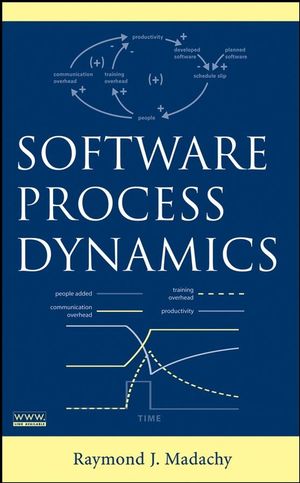Software Process DynamicsISBN: 978-0-471-27455-1
Hardcover
632 pages
January 2008, Wiley-IEEE Press
 This is a Print-on-Demand title. It will be printed specifically to fill your order. Please allow an additional 10-15 days delivery time. The book is not returnable.
|
||||||
Preface.
PART 1 FUNDAMENTALS.
Chapter 1 Introduction and Background.
1.1 Systems, Processes, Models, and Simulation.
1.2 Systems Thinking.
1.3 Basic Feedback Systems Concepts Applied to the Software Process.
1.4 Brooks's Law Example.
1.5 Software Process Technology Overview.
1.6 Challenges for the Software Industry.
1.7 Major References.
1.8 Chapter 1 Summary.
1.9 Exercises.
Chapter 2 The Modeling Process with System Dynamics.
2.1 System Dynamics Background.
2.2 General System Behaviors.
2.3 Modeling Overview.
2.4 Problem Definition.
2.5 Model Conceptualization.
2.6 Model Formulation and Construction.
2.7 Simulation.
2.8 Model Assessment.
2.9 Policy Analysis.
2.10 Continuous Model Improvement.
2.11 Software Metrics Considerations.
2.12 Project Management Considerations.
2.13 Modeling Tools.
2.14 Major References.
2.15 Chapter 2 Summary.
2.16 Exercises.
Chapter 3 Model Structures and Behaviors for Software Processes.
3.1 Introduction.
3.2 Model Elements.
3.3 Generic Flow Processes.
3.4 Infrastructures and Behaviors.
3.5 Software Process Chain Infrastructures.
3.6 Major References.
3.7 Chapter 3 Summary.
3.8 Exercises.
PART 2 APPLICATIONS AND FUTURE DIRECTIONS.
Introduction to Applications Chapters.
Chapter 4 People Applications.
4.1 Introduction.
4.2 Overview of Applications.
4.3 Project Workforce Modeling.
4.3.1 Example: Personnel Sector Model.
4.4 Exhaustion and Burnout.
4.4.1 Example: Exhaustion Model.
4.5 Learning.
4.6 Team Composition.
4.7 Other Application Areas.
4.8 Major References.
4.9 Chapter 4 Summary.
4.10 Exercises.
Chapter 5 Process and Product Applications.
5.1 Introduction.
5.2 Overview of Applications.
5.3 Peer Reviews.
5.4 Global Process Feedback (Software Evolution).
5.5 Software Reuse.
5.6 Commercial Off-the-Shelf Software (COTS)-Based Systems.
5.7 Software Architecting.
5.8 Quality and Defects.
5.9 Requirements Volatility.
5.10 Software Process Improvement.
5.11 Major References.
5.12 Provided Models.
5.13 Chapter 5 Summary.
5.14 Exercises.
Chapter 6 Project and Organization Applications.
6.1 Introduction.
6.2 Overview of Applications.
6.3 Integrated Project Modeling.
6.4 Software Business Case Analysis.
6.5 Personnel Resource Allocation.
6.6 Staffing.
6.7 Earned Value.
6.8 Major References.
6.9 Provided Models.
6.10 Chapter 6 Summary.
6.11 Exercises.
Chapter 7 Current and Future Directions.
7.1 Introduction.
7.2 Simulation Environments and Tools.
7.3 Model Structures and Component-Based Model Development.
7.4 New and Emerging Trends for Applications.
7.5 Model Integration.
7.6 Empirical Research and Theory Building.
7.7 Process Mission Control Centers, Analysis, and Training Facilities.
7.8 Chapter 7 Summary.
7.9 Exercises.
Appendix A: Introduction to Statistics of Simulation.
A.1 Risk Analysis and Probability.
A.2 Probability Distributions.
A.3 Monte Carlo Analysis.
A.4 Analysis of Simulation Input.
A.5 Experimental Design.
A.6 Analysis of Simulation Output.
A.7 Major References.
A.8 Appendix A Summary.
A.9 Exercises.
Appendix B: Annotated System Dynamics Bibliography.
Appendix C: Provided Models.
References.
Index.



